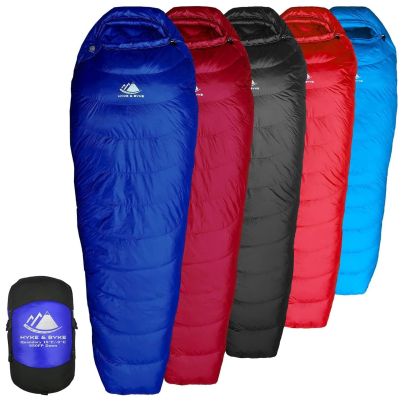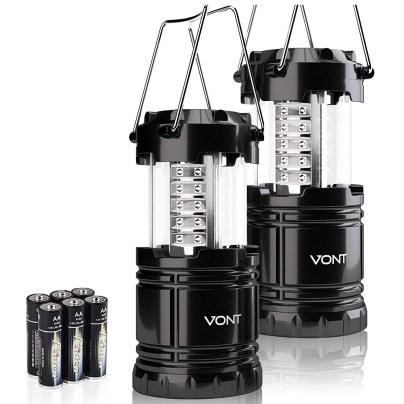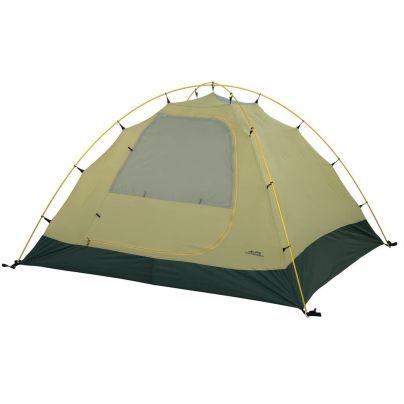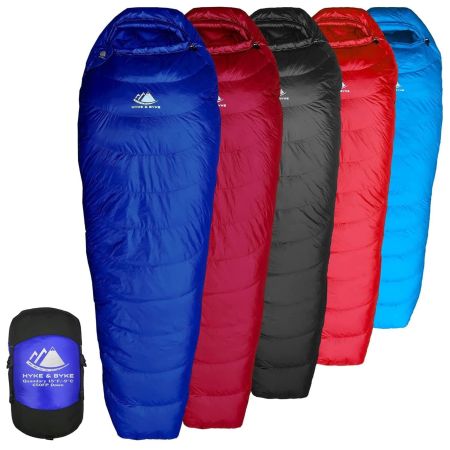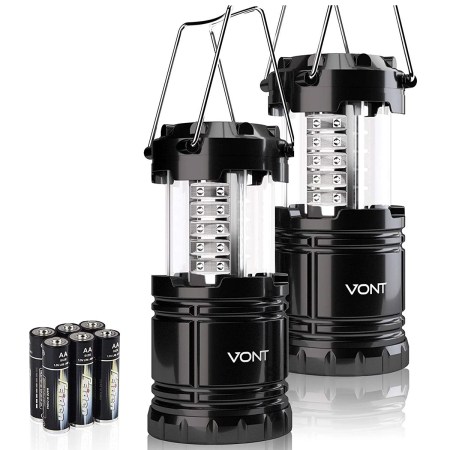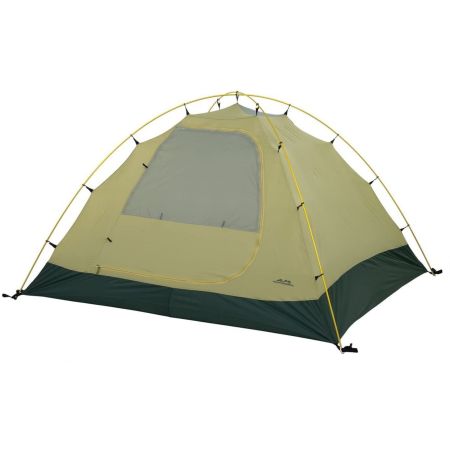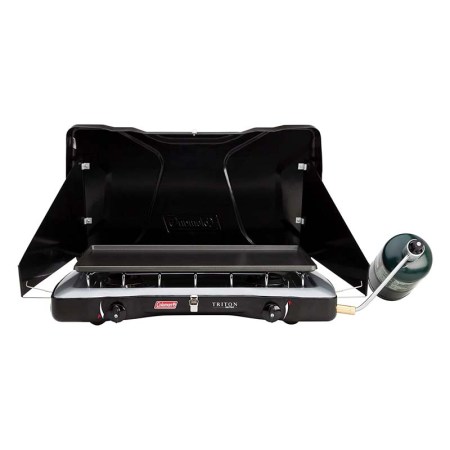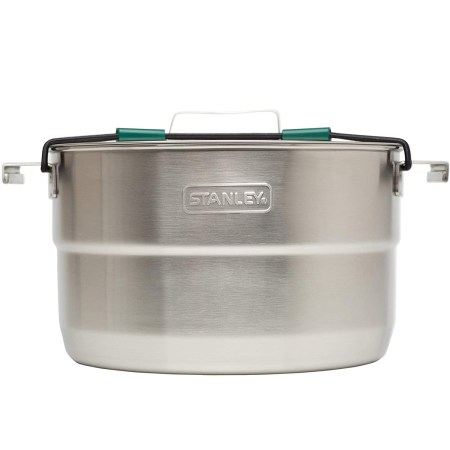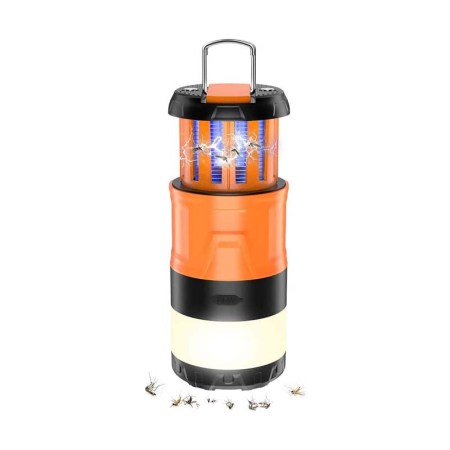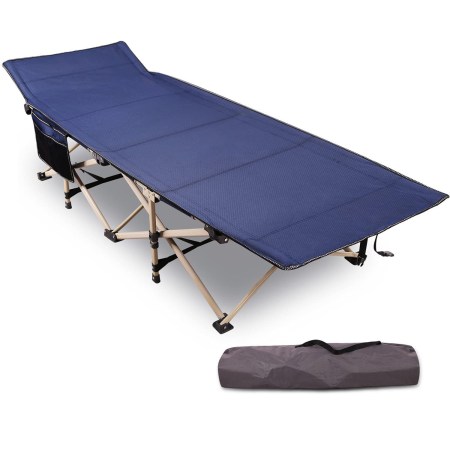We may earn revenue from the products available on this page and participate in affiliate programs. Learn More ›

Whether it’s a weekend fishing trip, a cross-country journey, or any other outdoor adventure, having the right gear will make the entire experience more enjoyable.
While you can’t bring all the amenities of home with you, “roughing it” doesn’t have to be primitive or miserable. Bringing some of the best camping gear into the woods will help ensure that you enjoy the great outdoors while staying comfortable, well fed, dry, and warm.
The best camping gear has to be durable, packable, and convenient to use. It shouldn’t take up a bunch of space in your vehicle or an entire day out of your trip to set up. However you like to camp, it’s important to remember that simplicity and functionality are absolutely key.
This list will help you put together a kit of the best camping gear for your wilderness adventures. You’ll find essential cookware, comfortable seating options, and gear to help beat the weather. These necessities will help you tackle a weekend outdoors, breathe some fresh air, and get away from the hustle and bustle in comfort.
- BEST OVERALL: Hyke & Byke Quandary Hydrophobic Down Sleeping Bag
- BEST BANG FOR THE BUCK: Vont 2 Pack LED Camping Lantern
- BEST TENT: ALPS Mountaineering Taurus 4-Person Tent
- BEST CAMPING STOVE: Coleman Gas Camping Stove Triton+ Propane
- BEST CAMPING COOKWARE: Stanley Base Camp Cook Set for 4
- BEST BUG CONTROL: Sahara Sailor Camping Lantern with Bug Zapper
- BEST CAMPING COT: REDCAMP Folding Camping Cots for Adults
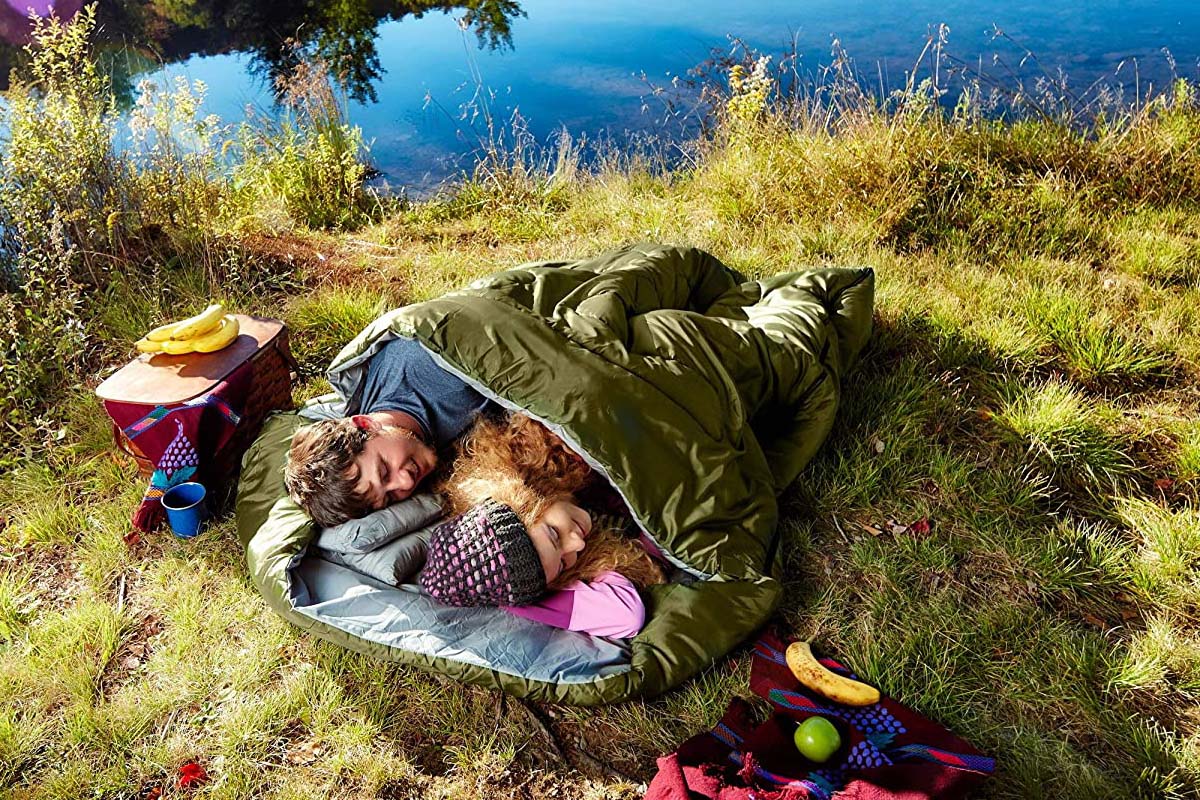
Types of Camping Gear
Curating a collection of the best camping gear can go in a few directions. There is gear for deep-woods camping, car camping, and backpacking. This list includes the essential gear you’ll need to get back to nature. It’s less about gadgets and electronics, and more about just getting out under the stars.
Shelter
The first essential piece you’ll need is some form of shelter. Shelter comes in so many forms, including tents for the ground, truck bed tents, camping hammocks, and campers.
In most cases, basic tents work very well. Unlike the tents of the past, modern tents are easier to set up and break down. Today’s models also have better waterproofing. You can get them in several sizes, from footprints just large enough for one person to sleep in to huge family-sized models. These bigger tents often have sleeping wings, central “living” spaces, and awnings.
You might also consider an additional covered space like a screen room or canopy. A screen room provides a bug-free space for food and relaxing, while a canopy can provide some shade on a sunny summertime campsite.
It’s a good idea to keep some extra tent stakes on hand, as well. They’re easy to lose or forget, and accidentally driving them into a rock can break them.
Sleeping Bag
If you don’t sleep well on your camping trip, it can be hard to enjoy yourself. Having the right gear can help.
At a minimum, you’ll need a sleeping bag to keep warm and cozy overnight, even in the summer. Most sleeping bags have a temperature designation to describe the lowest temperature they’re suitable for. Grabbing a zero-degree temperature bag for a fall trip is probably fine, but you might overheat if you use it in summer.
Pairing your sleeping bag with an inflatable or expandable camp pillow will help as well. You can also purchase an inflatable or foam sleeping pad to place underneath your sleeping bag for a little cushion and insulation.
If you’ve got the room and the budget allows, a sleeping cot can do wonders for your sleep. They’re comfortable and hold you up off the ground, enabling you to avoid sleep-stealing rocks and roots.
Clothing and Footwear
Having the proper clothing and footwear on your trip will go a long way toward keeping you comfortable. You’ll want rugged clothing that packs easily and dries quickly. Pants and shorts made from technical materials like ripstop nylon and polyester are ideal. They’ll be comfortable and breathable, dry quickly, and provide some protection from the sun.
In cooler temps, you might consider bringing a high-quality hiking jacket. From down-filled packable jackets to fleece half-zip sweaters, a hiking jacket should keep you warm (but not too warm). However, it needs to be light enough to not weigh you down on the trail.
Sturdy footwear is a must-have. Trail running shoes and hiking boots will ensure you have plenty of grip and support for knocking around the campsite or for serious treks. Pair them with a pair of hiking socks (typically a wool-blend), and your feet will stay warm, even if they get damp.
Cooking
There’s nothing quite like a great camp meal after a long day on the trail or swimming in the lake. The best camping cooking gear will allow you to prepare gourmet meals far from any actual kitchen.
Starting with the basics, you’ll want some camping cookware, dishware, and utensils. Many sets come with just about everything you need, so it’s worth shopping around and finding the right kit.
There are plenty of options when it comes to actually cooking the food. You can use a basic fire-pit grill grate that stands over a burning fire. You can also find folding camp grills and collapsing camp stoves, which allow you to cook with more easily-controlled temperatures.
Cleaning up is just as important, as you don’t want critters sneaking onto your site and picking through your garbage. Be sure to pack some trash bags for waste, and be sure to designate some for recyclable items. Keep environmentally safe dish soap on hand for cleaning pots and pans.
Finally, food storage is a consideration. A well-insulated cooler is important if there’s no concern for keeping the campsite light and mobile. With a bit of ice, you’ll be able to keep drinks and food cool enough for several days.
Lighting
Whether it’s for relaxing or because you heard a bump in the night, proper lighting is important on a camping trip. Setting up some string lights or LED lanterns will illuminate your site, helping you avoid trip hazards like roots, rocks, and tent cords.
Equally important as site illumination is a rugged flashlight. You should have something that you can take into the woods in the middle of the night should the need arise. Also, if there’s an issue with the tent after dark, like a tent pole slipping from its proper place, a flashlight will help you identify and fix the problem quickly. You might even consider a headlamp so you can work hands-free.
Hygiene
Leaving the comforts of home behind means you’ll have to figure out how to stay clean and comfortable. While a little dirt is entirely acceptable, you need to remain healthy when out in the woods.
If your tent is staying put, you might consider a camping toilet. While not the most pleasant thought, having a place to relieve yourself will allow you to stay comfortable and avoid odors and messes. These toilets use microbes to break down waste and prevent offensive smells. Keep in mind that you’ll have to dump them in an approved dump station, however.
If you’re not using a camping toilet, you’ll still need to keep some toilet paper on hand. RV and boat toilet paper breaks down quickly in camping toilets, but also in a “cat hole” (the hole you’ll dig to relieve yourself in, preferably off the trail).
A portable camp shower can provide a big boost in comfort as well. You can find solar-heated models that will provide warm bathing water as opposed to frigid water from a hose or creek. If privacy is a concern, be sure to purchase a surround.
Safety and Utility Tools
You’ll need some specific tools. A sturdy hatchet and camp saw can help collect firewood, while a box of matches, flint, or a lighter can make starting your blaze a snap.
A great pocket knife helps, as well. From shaving strips of wood for kindling or cutting ropes, or fixing equipment that fails on your trip, a multitool is almost a necessity. Find one with a strong knife, pliers, a pair of screwdrivers, and a small saw for the best functionality.
Keeping some spare batteries at the ready can be a great idea as well. Flashlights, radios, and lanterns can tear through batteries, so stock up on them before you head off the beaten path.
Beyond a good flashlight, there are some other things you should keep in your camping gear to help stay safe. The basics include sunscreen, bug spray, and a comprehensive first-aid kit. The kit should include burn cream, antibacterial cream, bandages, chemically activated ice packs, athletic tape, and tweezers. Pain relief and antihistamines are also important.
As far as wildlife goes, there are few items you might want to keep in your pockets or backpack. A bear banger, which is essentially a shotgun shell without the deadly projectiles, can scare large animals away. Bear spray is also particularly effective, as it’s really just long-range pepper spray.
It’s also a good idea to keep a water filter or water purification pellets on hand to ensure you’ll have potable water—which is much more important than food in a survival setting should your trip take a southerly turn.
Navigation and Communication
If you’re planning on heading into the backwoods, it’s important to keep some emergency communication equipment on hand, as well as some navigation tools. A whistle, compass, and topographical map are the bare minimum. Be sure to understand how to read a map and plot a course if you’re heading into remote territories.
Also, a personal locator beacon will allow you to send up a red flag should you get into particularly hot water. These electronic beacons alert authorities to your location and send help. Coupled with a good handheld GPS (separate from your phone) will help ensure you arrive at your planned destination and back home safely.
What to Consider When Choosing Camping Gear
There are some things to keep in mind when choosing the best camping gear. The different types of camping, as well as your location, will have a lot to do with choosing the right gear for your trip. Before you hit the trail, keep these things in mind.
Type of Camping
“Camping” is relative. Some folks consider sleeping in a 35-foot trailer with a queen-size mattress camping. Others need to enjoy the wind making the trees sway from the rugged comfort of their camping hammock to feel like they’re away from it all.
Basic camping in a state or private campground doesn’t require the same type of gear that deep woods, remote camping does. If you’re able to pull your car or truck right up to your campsite, you don’t need to worry about keeping things lightweight and backpackable.
When hitting the trail and setting up a new campsite every night, your gear has to remain minimal but functional, sturdy but lightweight. You’ll want to forgo camp chairs and grills, packing a lightweight hammock and fire grill grate instead.
Comfort vs. Essential Gear
The classic case of need vs. want. Planning your trip requires you to think about what you actually need versus what you want, and if you have room for extra creature comforts.
It’s entirely possible to make it through your camping trip without a radio or camp games, but if you have the room in your vehicle, and you can drive right up to your site, you might consider bringing them.
However, if you’re backpacking, space and weight are at a premium. Instead of that radio, you might choose a GPS. In lieu of camp games, a puzzle book or novel might be a more logical trail companion.
The idea is to weigh out the extras that provide comfort and decide if you have room for them. Never trade essential gear for comfort gear.
Access to Amenities
Your location will have a lot to do with what you need to keep on hand. Staying in a campground with a camp store requires far less planning than hitting the trail on foot, planning stops at general stores on the map along the way.
Staying in a campground usually provides easy access to showers and firewood, so staying clean and comfortable shouldn’t be an issue. On the trail, however, scrounging for firewood may be necessary. You might also have to bathe in a stream or fill a solar shower to stay clean.
Access to food and water is equally as important. If you’re camping close to a town or grocery store, you won’t have to plan quite as much for an emergency like running out of food or drinking water. If you’re backpacking along remote trails, however, you better have a backup, like some granola bars and a water filter.
Also, consider your access to a toilet so you can plan on what you need to bring with you, such as a camp toilet and toilet paper.
Length of Trip
Determining how long you’re staying in a campground or how much ground you’re going to cover over the course of your trip is important. If you’re staying on a remote site for a day or two, a cooler of food and water should suffice. When staying out for a couple of weeks, additional planning will be needed.
Likewise, a weekend backpacking trip will require planning, as far more supplies are required when tackling an entire state park on foot over several weeks.
The sum of it is this: Longer trips require more gear and supplies. Either plan to bring it with you, or plan out stops throughout your travels to resupply.
Environment and Season
One of the best parts about camping is planning the trip. Part of planning is taking the season, temperature, and changing weather conditions into consideration.
While fall is a beautiful time to hit the woods, it can get very cold and uncomfortable, depending where you live. If you’re heading out for some fully immersed leaf-peeping, be sure to bring warm clothes, sleeping bags, and a quality tent. Fall is a great time to think about upgrading from a sleeping pad to a cot, if you have the room.
Plan for the worst. Many remote locations don’t benefit from accurate weather reports, and some elevations can create their own weather conditions. If there’s even the slightest chance of inclement weather, bring gear to survive it (like rain gear and extra clothing).
Also, consider how close to nature you may be camping. If there’s a chance you may have a run-in or two with wildlife, keep the right gear on hand. A rope for hoisting food into a tree will help prevent a bear from stealing your stash of marshmallows and Hershey bars, but might only be necessary off the trail.
Safety and Risk Factors
Heading out into the woods, regardless of the camping accommodations, is always a bit riskier than a pampered life indoors, but the experiences are worth the risk. However, preparing for those risks is essential.
As mentioned earlier, a good first-aid kit is a must-have. You need to be sure that you can handle a medical situation if it arises, whether it be a scrape, bee sting, or twisted ankle.
Also, you can mitigate your risk by preparing. You’re far less likely to suffer hypothermia in a well-suited sleeping bag than bundled in a few blankets on the ground. A sturdy pair of hiking boots will prevent slips and falls and support your ankles better than a pair of flip-flops.
Keep factors like these in mind to ensure your trip goes as smoothly as possible.
Our Top Picks
If you need some help gathering the gear to head back to nature, check out the following list. These recommended camping products might be what you need when the rivers or mountains are calling.
Best Sleeping Bag
Hyke u0026 Byke Quandary Hydrophobic Down Sleeping Bag
See ItThe Quandary stands out for its unique design that maximizes heat retention, water-resistance, and compressibility. A filling made of 650 fill power duck down provides excellent loft and warmth. Yet all three sizes of the three-season Quandary weigh less than 3 pounds, keeping pack weights light.
When the description says ‘hydrophobic’, it’s not necessarily talking about the down but the shell. A water-resistant treatment protects the down from moisture to maintain body heat better. Horizontal baffles, or pockets, keep the down in place. Note that its narrow shoulder design may not work for those with a broader-than-average build.
Product Specs
- Type: Three-season
- Material: 650 fill power duck down and water-resistant shell fabric
- Packed Size: 10 inches long and 7.5 inches in diameter
- Weight: 2.71 pounds
Pros
- 400T 20 D ripstop nylon fabric liner
- Large footbox
- Lightweight and compressible
- Comes with storage bag
Cons
- Requires extra layers to stay warm in colder temperatures
Get the Hyke & Byke sleeping bag on Amazon.
Best Bang For the Buck
Vont 2 Pack LED Camping Lantern
See ItVont’s 2-Pack LED Camping Lanterns solve plenty of campsite darkness issues. These lanterns use 30 LEDs each to produce a bright, 360-degree pattern of light. With these lights set up, they can illuminate rocks and roots that you might otherwise trip over, or set up a late-night camp on a leg of your trip that took a little longer than expected. They’re also waterproof, so you don’t have to worry if you forget to bring them in before the rain falls.
Each light uses three AA batteries, though they’ll need to be purchased separately. When you want to lower the light, the LED housing slides down toward the base of the lantern, shutting off the lights when pushed down all the way and condensing down to just 4.8 inches tall.
Product Specs
- Lumens: 140
- Size: 3.4 by 3.4 by 4.8 inches
- Weight: 7.6 oz
- Quantity: 2
Pros
- Compact and lightweight
- Collapsible, space-saving design
- Water-resistant
- Batteries last up to 90 hours
Cons
- Batteries must be purchased separately
Get the Vont lanterns on Amazon and at Walmart.
Best Tent
ALPS Mountaineering Taurus 4-Person Tent
See ItIf you’re looking for a high-quality tent for a quick family getaway, the ALPS Mountaineering Taurus 4-Person Tent is worth a look. This polyester tent is a two-pole design that’s sturdy and easy to set up. It weighs just under 10 pounds and measures 7.5 feet wide by 8.5 feet long, with a center height of 52 inches, providing plenty of room for four people to sleep. It comes with a rain fly, and the floor has a waterproof coating to keep you dry.
The Taurus has some excellent built-in features as well: It has two doors so you can climb in and out of the tent from either side. When combined with the zippered screen windows, opening both doors will provide plenty of ventilation for airing out your sleeping quarters. This camping tent also has an interior gear loft for storing items and for hanging a camping lantern.
Product Specs
- Material: Polyester and Nylon Oxford fabric
- Capacity: 4 people
- Packed Size: 7 inches by 24 inches
- Weight: 9.7 pounds
Pros
- Easy two-pole setup
- Two-door entry; well ventilated
- Interior gear loft
- Heavy-duty 210D 110T Nylon Oxford floor
Cons
- Pricier than other tents
Get the Alps Mountaineering tent on Amazon and at Walmart.
Best Camping Stove
Coleman Gas Camping Stove Triton Propane
See ItIf you like to camp (and cook) in style, check out the Coleman Gas Camping Triton Propane Stove. This compact, tabletop stove will help you enjoy hot meals at camp. The dual-burner stove has two adjustable nozzles to help you dial in the perfect temperature. It uses small, 1-pound propane tanks (available here on Amazon) to provide plenty of heat for camp chili, pots of coffee, or delicious breakfast omelets.
The fold-out wings act as splash guards, catching grease so it won’t splatter onto your table. It has an easy-to-clean chrome surface and folds up into a compact 23 inches by 14 inches by 6 inches, taking up very little space when it comes time to pack up camp.
Product Specs
- Fuel: Propane
- Folded Size: 23 by 14 by 6 inches
- Weight: 4.85 pounds
Pros
- Compact tabletop model
- Two burners with adjustable temperature
- Fold-out wings catch grease
Cons
- Propane tanks must be purchased separately
Get the Coleman stove on Amazon and at Walmart.
Best Camping Cookware
Stanley Base Camp Cook Set for 4
See ItSometimes it can be tough to cook a delicious meal while camping, but the Stanley Base Camp Cook Set can help. With 21 pieces of cookware, it should be simple to prepare a variety of hot fireside meals that up to four people can enjoy. In this kit, you get a 3.5-liter pot, a 7-inch frying pan, spatula, serving spoon, and cutting board, making meal prep a snap. When it comes time to eat, it’s easy to see how four plates, bowls, and sporks to help fill your belly after a long day on the trail.
This kit also includes a heat-resistant trivet and a dish-drying rack. All of the pots and pans are stainless steel, which makes them durable and easy to clean. The entire kit fits inside of the pot, while an included bungee cord holds the lid shut for easy travel.
Product Specs
- Material: Stainless steel
- Pieces: 21
- Packed Size: 3.7 quarts
Pros
- Accommodates up to 4 people
- Pieces store easily in one pot
- Includes a dish-drying rack
Cons
- Not ideal for solo or 2-person camping
Get the Stanley cook set on Amazon.
Best Bug Control
Sahara Sailor Camping Lantern with Bug Zapper
See ItIf you’re looking for a camping lantern that provides light but also keeps the bugs off your bag, the Sahara Sailor Camping Lantern with Bug Zapper might be worth a look. This lantern uses built-in rechargeable batteries that you can juice up with the included USB cord. The lights have three modes to allow you to throttle your battery life for conservation purposes. The flashlight and lantern mode both provide 300 lumens of light, while the SOS mode will attract help if you need it.
The bug zapper collapses inside of the lantern, allowing you to pull it out when it gets buggy, but tuck it away and save battery life when the bugs subside. This lantern is drop-tested and water-resistant, making it rugged for camping trips and other outdoor pursuits.
Product Specs
- Lumens: 300
- Size: 5.2 by 3.62 by 3.62 inches
- Weight: 0.53 pounds
Pros
- Camping lantern and bug zapper
- 3 light settings
- Drop-tested and water-resistant
- Includes an SOS mode
Cons
- Some users report charging issues
Get the Sahara Sailor bug zapper on Amazon and at Walmart.
Best Camping Cot
REDCAMP Folding Camping Cots for Adults
See ItSleeping on the ground can be uncomfortable, and there’s no shortage of bugs and crawling critters in the woods. If you like to get off the ground when you head to bed, the REDCAMP Folding Camping Cot is a great choice. This cot measures 75 inches long, 28 inches wide, and 15 inches tall, large enough for all but the tallest adults. It has a 500-pound weight capacity too, though the cot weighs only 17 pounds, so it is plenty portable.
When packed up, the REDCAMP cot measures only 41 inches long, 9 inches wide, and 7 inches deep, fitting into a car’s trunk without issue. It also has a pocket on the right side of the bed to hold a book or your phone.
Product Specs
- Weight Capacity: 500 pounds
- Weight: 17 pounds
- Packed Size: 41 by 9 by 7 inches
Pros
- Sturdy metal legs
- No assembly required
- Comes with carry bag
Cons
- Thin mattress
Get the REDCAMP camping cot at Amazon, Walmart, and Sears.
Our Verdict
For a good night’s sleep on your next camping trip, we recommend the Hyke & Byke sleeping bag with its cozy down fill and three-season functionality. If you’re looking for shelter as well, consider the reliable ALPS Mountaineering tent that accommodates 4 people.
How We Chose the Best Camping Gear
Choosing the best gear for camping involved researching the top products in each category. The featured list only includes camping gear from reliable, trustworthy brands. We made sure to include gear for a variety of camping needs, including sleeping, shelter, cooking, and bug control.
When narrowing down the options, we focused on products that fold or collapse for compact storage. A few products on the list also include a storage bag. The top picks are also lightweight and easy to carry. As a whole, the featured list represents the key items one would need for a safe and enjoyable camping experience.
FAQs
Now that you know what to look for in the best camping gear, you might have other questions that you hadn’t thought of before. Here is a collection of the most frequently asked questions about camping gear. If you don’t find the answer you’re looking for here, you can contact your gear’s manufacturer and speak to their customer service department.
Q: What are 10 essentials for camping?
The 10 most important things to have with you on a camping trip are:
- Navigation tools (compass, map, GPS)
- Nutrition (food, granola, snacks)
- Hydration (water, filter tubes or pellets)
- Sun protection (UV-resistant clothing, sunscreen)
- Insulation (warm clothing, temperature-appropriate sleeping bag)
- Lighting (headlamp, lantern, flashlight)
- First-aid supplies (bandages, ice packs, aspirin, antibacterial, antihistamine)
- Repair supplies (tools, duct tape, cord for lashing)
- Communication devices (phones with extra battery packs, two-way radios, personal locator beacons)
- Shelter (tent, camping hammock, even your car)
The proper gear really depends on the situation. Summer camping might not require heavily insulated clothing, and campground stays don’t normally require GPS or personal locator beacons.
Q: What should you not bring camping?
There are certain things you shouldn’t bring camping. For one, anything that becomes dangerous when broken should stay home, like glassware or mirrors (aside from a signaling mirror). Also, other than essentials like GPS and phone, most electronics should stay behind. Also, certain scents in perfumes and hair products actually attract bugs, so you might consider leaving them home as well.
Q: How do you pitch a tent by yourself?
Most modern tents are very easy to pitch by yourself.
- Spread the tent out on the ground.
- Stake the corners into the ground.
- Straighten poles and slide them together.
- Insert through the pole sleeves or clips.
- Place the pole ends in their appropriate pockets to create tension and raise the tent roof.
- Use tent cords to create tension on the tent fabric.
Q: What is a 3-season sleeping bag?
A sleeping bag labeled as 3-season means it will keep you warm in all but the coldest temperatures in winter, while not baking you alive as you sleep in summer.
Q: Is a sleeping pad necessary for camping?
“Necessary” is relative, but in most cases, a sleeping pad will improve your sleep tremendously. In colder temps, it can add a layer of insulation between your sleeping bag and the ground.
